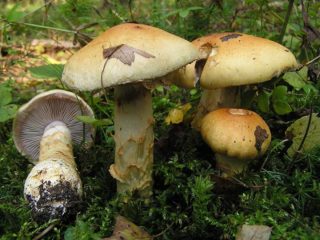Content
Cordyceps ophioglossoides is an inedible member of the Ophiocordyceps family. The species is rare and grows from August to October in mixed forests. Since this specimen is not eaten, you need to know the external description and view photos and videos.
What does Cordyceps ophioglossoides look like?
Cordyceps ophioglossoides has an unusual, bizarre appearance, making it difficult to confuse it with other representatives of the fungal kingdom. The fruit body is elongated, up to 10 cm long.This specimen is a parasite and grows on earthen mushrooms singly or in small families.
The fruiting body, the stroma, has a clavate-elongated shape with a pronounced expansion at the base. The spore layer is lemon-colored when young; as it grows, the color changes to dark olive or black. The underground part of the mushroom has a light yellow tone, the aboveground part is reddish or dark brown. The color depends on the place of growth.
Where do Cordyceps ophioglossoides grow?
The parasitic species can be found in coniferous and deciduous forests from July to October. Cordyceps ophioglossoid prefers damp places, so it grows in moss, next to swamps, and along the banks of reservoirs.
Is it possible to eat Cordyceps ophioglossoides?
In Russia, Cordyceps ophioglossoidum is considered inedible and hallucinogenic. The pulp is hard, tasteless and odorless, contains ergotamine, which causes an ergotism-like psychotropic reaction.
Cordyceps ophioglossoides secretes ergotamine during the breeding season. When consumed, this substance causes severe poisoning. First signs:
- smooth muscle spasm;
- severe pain in the epigastric region;
- mental disorder;
- hallucinations appear;
- nausea, vomiting;
- diarrhea;
- weakness in the legs;
- blood pressure increases;
- cold, clammy sweat;
- tachycardia;
- the person becomes aggressive;
- cataract develops.
When the first signs appear. It is necessary to provide first aid:
- calling a medical team;
- lay the victim down, put heat on the stomach and limbs;
- give activated carbon and plenty of warm water;
- induce vomiting;
- release from constricting clothing.
There are two forms of ergotism:
- Convulsive – pain, cramps, convulsions, dizziness, stupor, agony.
- Gangrenous – the functional functioning of tissues is disrupted due to a sharp narrowing of the capillaries.
Experienced mushroom pickers recommend passing by unknown specimens, since many mushrooms can cause irreparable harm to the body.
How to distinguish Cordyceps ophioglossoides
To protect yourself and your loved ones, you need to know the external characteristics of Cordyceps ophioglossoides and its counterparts:
- Cordyceps armed - an inedible, but medicinal representative of the mushroom kingdom, which helps to cope with many diseases. The species can be recognized by its elongated, club-shaped, orange-colored fruiting body. The whitish pulp is fibrous, without taste or aroma, and has medicinal properties. It has antibacterial and anti-inflammatory effects, and also helps with gastrointestinal diseases, hepatitis, and cirrhosis of the liver. Thanks to this type, blood vessels are strengthened, the body gets rid of bad cholesterol and toxins.
- Cordyceps capitate - a hallucinogenic representative, similar in appearance to a match. It parasitizes underground fungi in mixed forests. It begins to bear fruit in June and lasts until the first frost.
Conclusion
Cordyceps ophioglossoides is a hallucinogenic representative of the mushroom kingdom. If consumed, it causes severe poisoning, which can be fatal. Therefore, in order not to harm your body, before a quiet hunt you need to familiarize yourself with the external data and be extremely careful when collecting.












